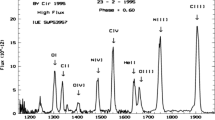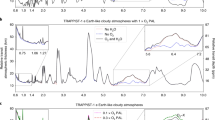Abstract
It has recently been suggested1 that the absorption line v = 26.13 MHz that we had detected2 in the direction of Cassiopeia A might be a recombination line due either to carbon (C631α) present in H I clouds or to heavier elements of hot gas. Observations reported here taken in February 1981 suggest that the low-frequency attenuation in the spectrum of Cas A is due to the presence of a cold cloud of ionized carbon.
Similar content being viewed by others
References
Blake, D. H., Crutcher, R. M. & Watson, W. D. Nature 287, 707–708 (1980).
Konovalenko, A. A. & Sodin, L. G. Nature 283, 360–361 (1980).
Konovalenko, A. A. & Sodin, L. G. Soviet astr. J. Lett. 5, 663–664 (1979).
Shaver, P. A. Pramana 5, 1–29 (1975).
Shaver, P. A. Astr. Astrophys. 49, 1–16 (1976).
Casse, J. L. & Shaver, P. A. Astr. Astrophys. 61, 805–808 (1977).
Shaver, P. A., Pedlar, A. & Davis, R. D. Mon. Not. R. astr. Soc. 177, 45–50 (1976).
Braude, S. Ya. & Tchayevski, E. V. Izv. Vuzov, Radiofiz. 5, 211–215 (1962).
Author information
Authors and Affiliations
Rights and permissions
About this article
Cite this article
Konovalenko, A., Sodin, L. The 26.13 MHz absorption line in the direction of Cassiopeia A. Nature 294, 135–136 (1981). https://doi.org/10.1038/294135a0
Received:
Accepted:
Issue Date:
DOI: https://doi.org/10.1038/294135a0
- Springer Nature Limited
This article is cited by
-
The modern radio astronomy network in Ukraine: UTR-2, URAN and GURT
Experimental Astronomy (2016)
-
High resolution radio recombination line observations
The Astronomy and Astrophysics Review (1992)
-
A digital correlation receiver for the GEETEE radio telescope
Journal of Astrophysics and Astronomy (1990)
-
Observation of highly excited radio recombination lines towards Cassiopeia A
Nature (1985)
-
A survey of recombination line emission from the galactic plane at 325 MHz
Journal of Astrophysics and Astronomy (1985)





